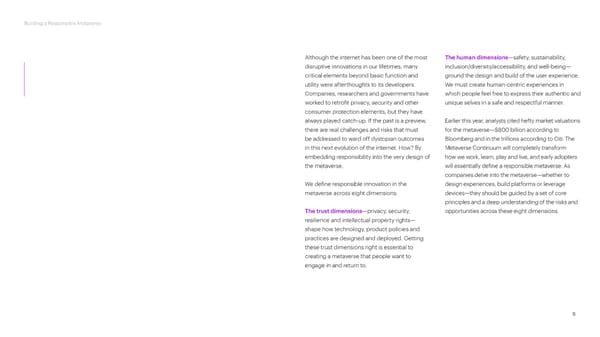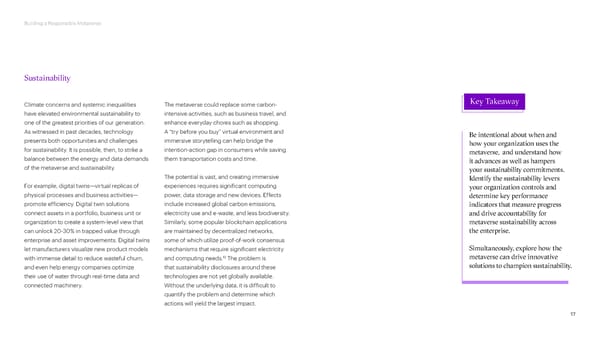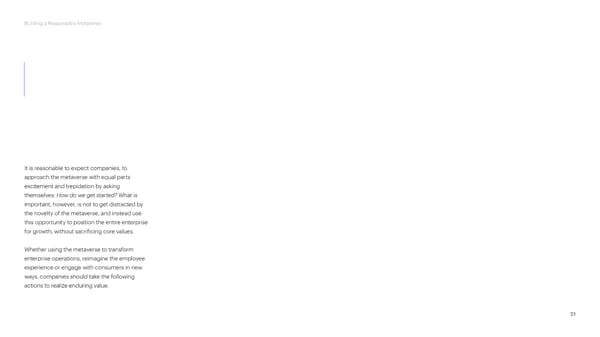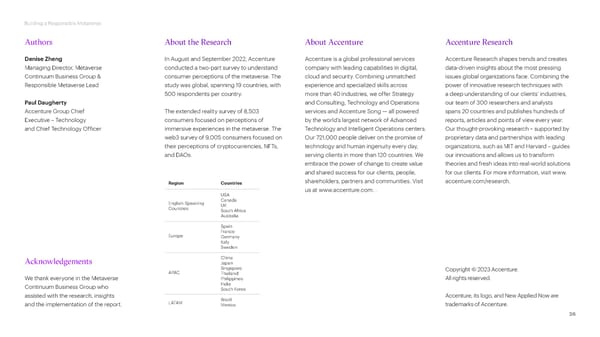Building a Responsible Metaverse | Accenture
The internet has changed everything about how we interact with friends, family, colleagues and clients—and not all for the better. At the inception of the internet, trust and safety were an afterthought—and companies, governments and nonprofits have long been playing catchup on security, cyberbullying and everything in between.
metaverse
responsible metaverse
Accenture
Technology
Report
2023
Building a Responsible Metaverse Leading with trust and human-centricity
Building a Responsible Metaverse 3 5 9 21 24 2
Building a Responsible Metaverse This is an important lesson to remember now, particularly with the rise of new metaverse platforms built on different governance models and content-creation economies enabled by blockchain that utilize immersive human- Remember Second Life? When it launched in machine interfaces. Virtual experiences may be 2003, it was arguably the first major metaverse more advanced today, but nothing has changed environment. Second Life attracted thousands when it comes to human sentiment. of early adopters who could play and create in a virtual community with one guiding principle: “Be nice.” This approach worked—until it didn’t. Unpleasant or harmful player behavior, inappropriate images or other uncomfortable As companies look to build their own metaverse situations proliferated quickly. Linden Lab, the experiences, they must put trust at the core of creators of Second Life, started banning harmful their strategy. The world needs a responsible behavior and adding features that allowed metaverse that is built with past lessons and people more control over what they saw and existing challenges in mind, so we can better how other avatars could interact with them. anticipate—and account for—what lies ahead. These features increased users’ trust, which Otherwise, the metaverse will not live up to its proved critical for retention and engagement. potential to transform how work is performed, Two decades later, Second Life endures, but how products and services are delivered, how one can’t help but wonder: what could Second goods are distributed and how businesses Life have become had it been built with our trust operate. and safety in mind from the start? 3
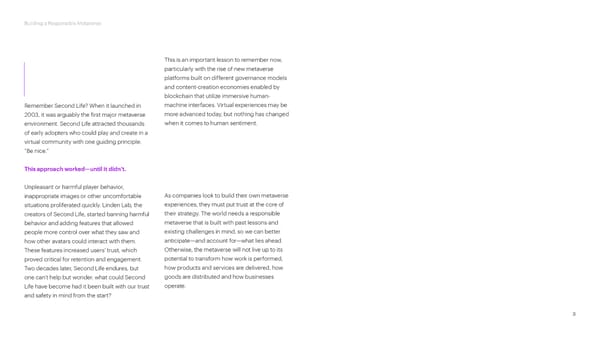
This is a modal window.
Building a Responsible Metaverse Between August and September 2022, Accenture conducted a two-part global study spanning 19 countries and 17,500 respondents to understand consumer perceptions of the metaverse (both extended reality and web3). The results revealed that consumers care about more than just the front-end experience and that organizations must dig deeper to earn their trust. Three key findings emerged from the study: 1. Respondents indicated that safety, security and privacy were the most important elements. This was consistent across age group, gender and geography. 2. The metaverse is at a fork in the road when it comes to trust. Just over half of respondents believe the metaverse will be the same as social media in terms of securing consumers’ data, concern for respondents—nearly 60% of consumers cited convergence of technologies in the metaverse tech stack protecting their safety and ensuring their privacy. “strong security and data protection capabilities” as a top factor brings new challenges. The framework is characterized The other half is about equally split on whether when selecting NFT marketplaces.2 by eight dimensions that we believe are fundamental to 1 the metaverse or social media will be worse. building both trusted and human-centric experiences in the To earn and maintain users’ trust, companies must make metaverse. It is relevant to every organization—big or small, 3. The underlying ethos of crypto (e.g., sense of a complex array of questions and trade-offs related to private or public—and applies to builders, enablers and users decentralization, transparency) is technology, policy, ethics and business strategy. Companies alike. not the driver of consumer interest in will also have to apply past lessons to entirely new paradigms cryptocurrencies and NFTs. Consumers ranked around data, ownership and governance. Finally, we identify six major emerging challenges and explain potential financial value 4x more important than why these matter, as well as what organizations should the ethos of crypto. This aligns with our finding The following sections present a framework to guide consider as they enter the metaverse. that scams and other security threats are a top responsible innovation in the metaverse, particularly as the 4 4

Building a Responsible Metaverse Although the internet has been one of the most The human dimensions—safety, sustainability, disruptive innovations in our lifetimes, many inclusion/diversity/accessibility, and well-being— critical elements beyond basic function and ground the design and build of the user experience. utility were afterthoughts to its developers. We must create human-centric experiences in Companies, researchers and governments have which people feel free to express their authentic and worked to retrofit privacy, security and other unique selves in a safe and respectful manner. consumer protection elements, but they have always played catch-up. If the past is a preview, Earlier this year, analysts cited hefty market valuations there are real challenges and risks that must for the metaverse—$800 billion according to be addressed to ward off dystopian outcomes Bloomberg and in the trillions according to Citi. The in this next evolution of the internet. How? By Metaverse Continuum will completely transform embedding responsibility into the very design of how we work, learn, play and live, and early adopters the metaverse. will essentially define a responsible metaverse. As companies delve into the metaverse—whether to We define responsible innovation in the design experiences, build platforms or leverage metaverse across eight dimensions: devices—they should be guided by a set of core principles and a deep understanding of the risks and The trust dimensions—privacy, security, opportunities across these eight dimensions. resilience and intellectual property rights— shape how technology, product policies and practices are designed and deployed. Getting these trust dimensions right is essential to creating a metaverse that people want to engage in and return to. 5
Building a Responsible Metaverse Consumers are highly concerned Privacy Security Resilience Intellectual Property Rights about privacy in the metaverse. Only 4% claimed they were not • The primary purpose of collecting, • Security by design should focus on • The metaverse should be engineered to • Platforms should enforce intellectual property worried about this. Interestingly, processing, and sharing user data should hardening infrastructure and software operate in evolving and dynamic conditions rights through robust detection capabilities and we found that Millennials and Gen be to deliver value to the user. against novel threats, particularly and must be scalable and able to withstand comprehensive user education. cybercrime, fraud, and disinformation. and recover rapidly rom disruptions and Zers—digitally savvy consumers— • Design decisions should feature privacy adversarial cyber attacks. • Companies should invest in preventative were more concerned about robust defaults that are intuitive given the context • Companies should use an adaptive zero- measures and real-time identification 3 of the use case or experience. trust security model. • Platforms and devices should be capable mechanisms, such as trademark and privacy features in the metaverse. of supporting high-fidelity and low-latency copyright monitoring services and brand • Companies should implement innovative • Data protection should be in place to experiences that are immersive and protection tools. strategies to educate users about their protect the confidentiality and integrity of persistent for large numbers of global users privacy options in the metaverse. experiences, data and applications. to interact simultaneously, in real time. 67% of consumers agreed that they’d be more likely to engage— create, buy or trade collectibles—in NFT marketplaces that actively combat counterfeits.4 Figure 1. Eight dimensions of Responsible Metaverse 6

Building a Responsible Metaverse Inclusion, diversity and well-being comprise a growing concern. Consumers under 40 (Millennials and Gen-Z) were more likely to give greater importance to these dimensions than Baby Boomers and Gen-X. Inclusion, Diversity Safety & Accessibility Sustainability Well-being • Safety is the top priority in virtual environments. • Companies should design systems and • Companies should explore ways to use the • The metaverse should be leveraged to Decentralized Autonomous experiences to be inclusive and accessible. metaverse to become net more sustainable enhance and augment real-life experiences. • Platforms must proactively implement by using it as an alternative to energy and Organizations (DAOs) have policies, technologies and practices to • As a new vehicle for fostering empathy and carbon-intensive activities. • Devices, systems and digital environments questionable value. When asked discourage harmful content and behaviors. connection, the metaverse should ideally be should be rooted in preserving and improving about inclusion and diversity, a grounded on universal design principles to • When deciding how to build and select users’ mental and physical health. • Companies should invest in predictive and maximize usability and accessibility. hardware, software and platforms for the core tenet of DAOs, consumers real-time detection capabilities as well as in- metaverse, companies should evaluate • Ultimately, well-being in the metaverse is are split—48% believe that DAOs world features to empower users to manage • Context matters. Users should feel environmental impact, such as energy usage, directly correlated with human-centric design can enhance inclusion and their own safety. empowered to reinvent themselves if emissions, and e-waste. choices across all the dimensions outlined in diversity by allowing community they wish, but certain situations call for this framework. authenticity and real identities. • Users, creators, and operators should be self-governance, 43% have not educated about what they can do to reduce yet formed an opinion, and 9% the environmental footprint of the metaverse. 5 disagreed altogether. Figure 1. Eight dimensions of Responsible Metaverse 7
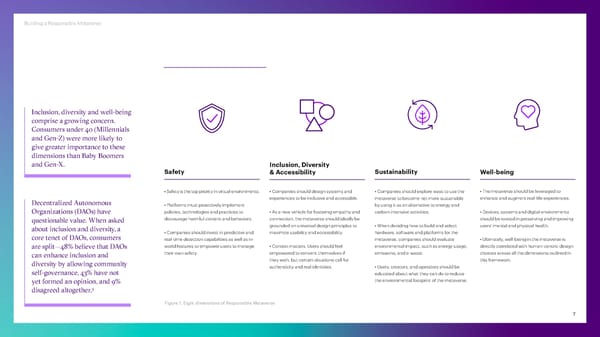
Building a Responsible Metaverse Studies show that trust is the decisive Lack of Transparency, variable in forming commitment, which Lack of Trust explains why users are more willing to engage with online platforms they consider trustworthy.6 This was also supported by our consumer study. For instance, when Billions of people around the world cannot recall prompted about factors that influenced a time in their lives when social media platforms their selection of NFT platforms, 59% of did not exist. But only a few remember a time consumers ranked strong security and data when these platforms were not controversial. protection capabilities at the top, more important than “ease of use” and “popularity In their early days, social media platforms of marketplace.” Across geographies and allowed like-minded people to connect and generations, more than 70% of respondents share information in novel ways that created agreed that robust privacy, safety and communities and social bonds. However, as security mechanisms would impact companies raced to monetize their services, their willingness to engage in metaverse they created algorithms and other tools that 7 facilitated the spread of information based experiences. on engagement. Consequently, harmful or inaccurate content spreads quickly and is difficult to police. Data and testing have shown the power of Social networks started as a force for good, but “illusory truth”: the more often a piece of a lack of transparency about how platforms are misinformation is repeated, the more likely it moderated and managed has radically shifted is that a person will believe it. And an internal sentiment. This is why the metaverse must start study at a social network showed that the with a clear understanding of the potential for amount of positive and negative information in harm rather than a hope that the worst will not in user’s feed can shift their emotions. Online happen.8 engagement, it turns out, influences our behavior, both online and off. 8
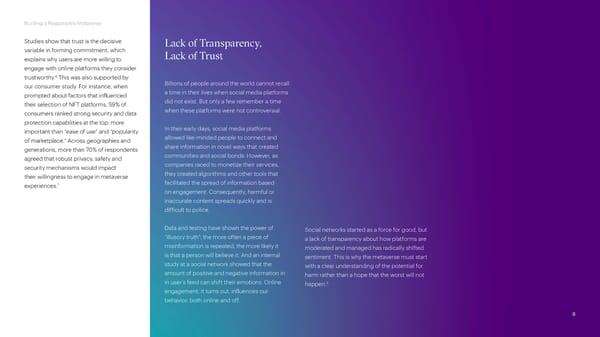
This is a modal window.
Building a Responsible Metaverse When the internet first took hold, it was basically What follows are six areas of focus that viewed as a way to communicate, share organizations should start exploring and information. The internet’s pace of evolution— understanding, right now, to ensure a safe and the challenges that came with it—were and secure metaverse that is as engaging and hard to predict. Hindsight tells us, though, that valuable for businesses as it is for users: companies should adopt frameworks that fit their people, customers and businesses, with 1. Privacy by design and by default responsibility as the North Star. Decisions on 2. Risks and rewards of tokenization everything from privacy to interoperability are 3. Interoperability easier to make when the risks are clearly defined 4. Digital safety and understood, as they were not in the early 5. Sustainability days of the internet. 6. Identity and inclusion Of course, there will always be unknowns in a space where innovation is flourishing. But identifying critical areas of focus and building in guardrails will provide a greater chance of alignment between the intended and actual experiences in the metaverse. The closer this alignment, the greater the trust—and the more successful the metaverse will be. 9

This is a modal window.
Building a Responsible Metaverse Privacy by Design and by Default enhanced data protection measures for high- For instance, how does compliance with the Key Takeaway risk data and novel uses of data, and proactively right to delete user data guaranteed by privacy New types of data and new online ecosystems inform people about how their data is being statutes work in a decentralized ecosystem breed novel privacy risks. The metaverse will likely safeguarded. These transparency measures will where entities from all over the world are make it easier to construct convincing deepfakes, go a long way in keeping users engaged and recording their transactions via an immutable Companies that implement detect emotional or psychological responses, and active, especially for certain demographics. In blockchain? How can organizations moderate intuitive privacy defaults and make it more difficult to truly erase information. fact, our study found that Millennials and Gen-Z content in a space where users are engaging in innovative transparency approaches The metaverse will generate an unprecedented were even more likely than consumers in older live interactions as avatars, including non-verbal are more likely to succeed at amount of data, including real time information generations to engage in the metaverse if there communication? How can notice and consent engaging and retaining people in about movement and physical attributes, spatial were enhanced data protection measures.9 mechanisms be best deployed in a realistic 3D the metaverse. Organizations can and social data about users’ surroundings, and environment? How to ensure that broader data further differentiate themselves leverage advanced machine learning that can Companies can win trust by designing protection, ownership and rights are consistently by anticipating users’ privacy deliver additional layers of insight. Physiological metaverse experiences with user privacy addressed across the entire technology stack? expectations in virtual worlds information such as facial expression and expectations built in from the start. Although Companies will need to innovate to not only based on analogous real-world attentional focus could reveal greater detail about it can be challenging to anticipate privacy create compelling metaverse experiences, but scenarios. Strong data protection people’s mental, physical and emotional states, expectations in online environments, one of the also to ensure privacy and data protection are practices create a baseline for trust while spatial data about users’ surroundings could great privacy opportunities of the metaverse lies built into those experiences from the start. when novel kinds of data are being paint a picture of peoples’ homes, places of work in its ability to replicate aspects of the real world. collected and processed. and social environments. This allows companies to leverage existing social and societal privacy norms from physical spaces Companies have an opportunity Companies can leverage this data to deliver (offices, homes, storefronts, entertainment to increase that trust by providing delightful, personalized experiences, innovate venues, etc.) to make intuitive privacy design proactive transparency and education new products and strengthen loyalty with users. decisions in similar virtual spaces. Privacy about the data protection measures At the same time, however, companies must defaults that reflect the expectations people they have put in place, especially for already have about privacy in the real world younger, more digitally savvy users. temper innovation with a strong play for user trust given privacy risks. automatically improve trust and engagement in virtual and augmented reality environments. Companies can win trust by People want to know their data is safe, especially designing metaverse experiences when new kinds of data are being collected Many questions remain for achieving both trust with user privacy expectations and processed. Companies should implement and privacy compliance in the metaverse. built in from the start. 10
Building a Responsible Metaverse The Risks and Rewards of Tokenization Although crypto and NFTs capture headlines, Although this seems like an ideal situation what truly matters is blockchain. In an era of for companies, respondents cited financial discontinuity and distrust, multiparty systems value as the primary motivator for engaging enabled by blockchain are rising in popularity. in cryptocurrencies and NFTs. This begs the question: Are consumers really interested in Companies now have unprecedented engaging with a brand through digital assets, opportunities to explore the tokenization of or is it simply about speculation? And if so, is it money, objects and identities. When we asked worth the risks? consumers how they perceived brands that were engaging in these activities, 50% claimed they To find out, companies must conduct a cost- admired brands accepting cryptocurrencies. benefit analysis to assess if there is value in a Moreover, consumers were 6x more likely to have specific blockchain use case or opportunity. a positive reaction to a brand engaging in NFTs They must understand the potential risks 10 than a negative reaction. (operational, financial, legal and reputational) and plan corresponding mitigation strategies by scoping engagement models, mapping interdependencies and carefully selecting partners. 11
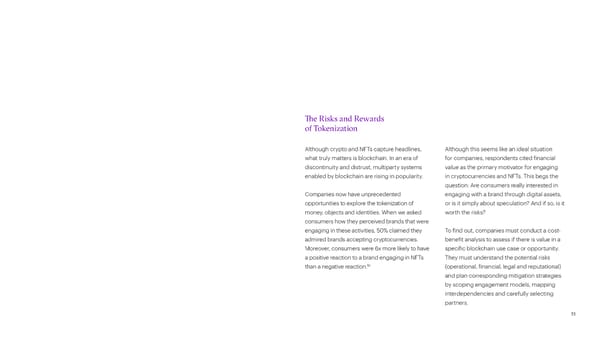
This is a modal window.
Building a Responsible Metaverse Figure 2 Key Takeaway Companies must decipher what is real and what is hype before engaging with digital assets. Before jumping into the “web3” movement, companies should explore the full range of options, including enterprise-grade platforms and Operational risk Financial risk Legal risk Reputational risk solutions. Whether you are just beginning • Limitations in ensuring data confidentiality • High “gas” fees to transact on certain • Legal and regulatory frameworks • Airdrops of inappropriate or illegal content or expanding your tokenization and data segregation blockchains applicable to digital assets and those who provide services related to them are • Questionable neighbors in virtual worlds journey, start by identifying your • Data corruption or total loss of • Extreme market volatility with respect to currently uncertain strategic objectives, defining what data resulting from failed processes / the value of a specific digital asset • Unverified identities of customers systems or from compromised • Challenges in complying with data your target audience truly values, digital wallets • Unverified identities of customers protection regulations such as GDPR and • Poor user experience and selecting trusted technology CCPA • Security vulnerabilities or loss of • Concerns over fraud, theft and market • Concerns over environmental, solutions and service providers that functionality resulting from unanticipated manipulation • IP infringement, ownership and licensing sustainability and the widening digital address concerns around privacy, changes to a blockchain network (forks) issues may arise with digital assets, divide • Difficulty integrating with third-party especially digital media security and safety. • Unclear governance of the network, payment processors or traditional fiat on/ • Concerns over misuse of personal data, including activities such as business off-ramps • Concerns over being held liable for fraud and theft continuity planning and continuous unknowingly participating in money improvement • Probabilistic settlement finality leading to laundering, sanctions violations or other unclear transaction completion fraudulent behaviors • Unpredictable software releases from opaque open-source governance • Lack of recourse and possible processes indemnification • Conduct that is considered deceptive or unfair and leads to legal penalties • Potential for larger risk exposure given secondary markets for some digital assets 12
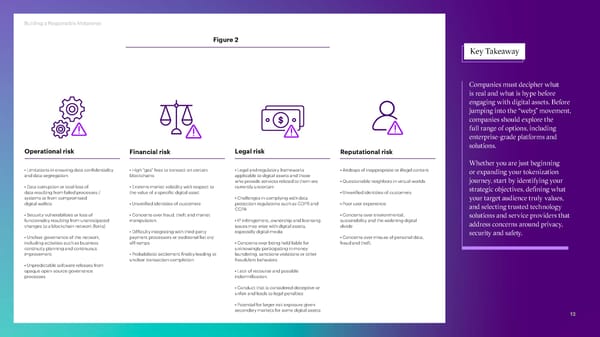
BBuiuilldinding a Rg a Reessppoonnssibiblle Me Meettaavveerrssee Our study found that 68% of consumers say they would like to use the same avatar across multiple platforms.11 Interoperability The many communities, platforms, marketplaces distributed systems and applications. The most and worlds of the metaverse are likely to operate likely outcome of these efforts and others is that with different degrees of openness. But users some parts of the metaverse will be built on open want to interact seamlessly with applications and and interoperable standards, while others will be service providers across virtual worlds and digital walled off and operate under proprietary standards. asset platforms—and there are opportunities to drive interoperability and openness into the In the longer term, companies must overcome foundation of the metaverse. several challenges to achieve interoperability. First, it is difficult to align economic incentives, We are currently creating an enterprise-grade and it is particularly hard to balance the and vendor-agnostic universal wallet that equities of new entrants and incumbents, as houses users’ tokenized assets such as money, well as those of platforms, publishers and objects and identities. The solution serves as a content creators. Second, technology must be window of interaction between various actors engineered to enable interoperability, which and metaverse platforms to enable verifiability, is a lengthy and time-consuming process trade, ownership and—most importantly— that requires mobilization of vast resources, trust between parties. In addition, several as well as collective agreement and action consortia and standards bodies, including the from metaverse platforms. Third, different Hyperledger Foundation, the World Economic approaches to metaverse platform governance Forum and the Khronos Group, have efforts (e.g., decentralized community-based or underway to improve interoperability across centralized governance) introduce additional complexities around security and privacy. 13
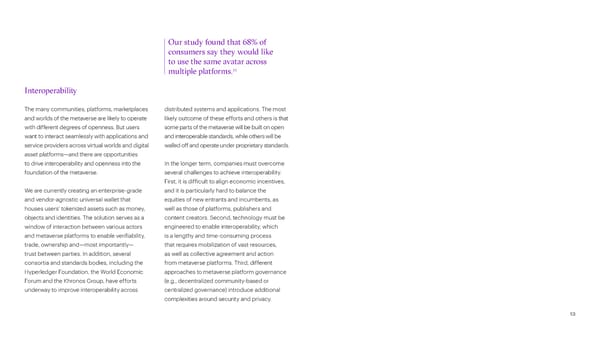
This is a modal window.
Building a Responsible Metaverse Governance Digital Assets Interoperability Device/OS User Base Players require at least 3 Axies (in-game Key Takeaway characters) to play. Axies are NFTs that can be bought and sold on NFT • ~400,000 daily active users as of November 2022, Decentralized marketplaces. Players earn Small Love Not interoperable Windows, Mac, down from ~2 million in November 2021 (Ronin – Ethereum-linked Potions (SLP), a type of in-game token, with other platforms. iOS, Android • ~40% of players came from Philippines as of 2022. sidechain) when completing a level. They can use Venezuela came in second. SLPs for breeding Axies and leveling up their creatures. Additionally, AXS is the game’s governance token. Device, platform and application MANA is the cryptocurrency that enables companies should prioritize creating Decentralized purchases of goods and services in-world, Not interoperable Web-based access only • 56,000 monthly active users the best user experience possible by (Ethereum) including LAND and ESTATE tokens. MANA with other platforms. for now (Windows, Mac) • ~7000 monthly unique wallets can be earned and bought on any crypto coming together to enable coherent exchange (i.e., Kraken, Coinbase). metaverse experiences across both V-bucks can be bought using fiat Not interoperable Android, Windows, Mac, PlayStation, • 400+ million registered users as of 2021 closed and open virtual worlds. Centralized currency. Used for purchasing with other platforms. Xbox, Nintendo Switch. Given the • 83+ million monthly active players as of 2021 avatar wearables, pickaxes, emotes, lawsuit between Apple and Epic, • ~60% of users are between the ages of 18 and 24 Battle Passes and more. Fornite is not available on Mac or iOS. • ~90% of users are male In the meantime, companies seeking In-world purchases can be made Not interoperable Requires Oculus headset. • 200,000 users as of Oct. 2022 to leverage the metaverse should Centralized through the Oculus Rift Store, with other platforms Mobile, PC, and web-based (a drop from 300,000 users in Feb) which currently only supports versions forthcoming • 10,000 unique worlds exist evaluate and plan for different select fiat currencies. • Targeted at users 18+ scenarios, understanding what is Mine coins can be bought using interoperable today and how the fiat currency. Used to purchase Not interoperable Windows, Mac, • 141 million monthly users in 2022, of which 112 million are active landscape might change in the near- Centralized skins and mods (i.e. modifications; with other platforms iOS, Android • The average player is a 24-year-old male modding allows users to create new • Most servers stem from North America and Europe to medium- term future. blocks, tools, etc.) • 55+ million daily active users Companies should invest in Robux can be earned or purchased • 200+ million monthly users Centralized using fiat currency. Used to buy Not interoperable Windows, Mac, • ~80% of users are under the age of 16 innovations such as a universal digital games and in-world goods with other platforms iOS, Android • Balanced gender split: 51% male, 44% female • Users in Europe, North America, and Asia have the most active wallet infrastructure to allow people to users (in that order). tokenize identities, money and objects, Decentralized SAND cryptocurrency used Not interoperable Windows, Mac, • 39,000 daily active users (Ethereum) to support transactions and with other platforms iOS, Android • 200,000 monthly active users and use them across digital worlds, engage in play-to-earn. • 4.1 million wallets • 90+ experience enabling much greater interoperability. Achieving this level of interoperability Linden dollar (L$) is used to buy will take significant time, coordination and sell virtual goods, property, Not interoperable Windows, Mac. Not • 70 million registered accounts Centralized and services. LindeX is the platform with other platforms available for mobile. • Daily average of ~200,000 users exchange for trading L$s to USD$ • In-game economic worth ~ $500 million since inception and financial resources. and vice versa. Decentralized UPX is the in-world currency that enables Not interoperable with other Web-based access only • ~140K unique active wallets as of November 2022 (EOS chain; delegated users to mint properties, purchase items, platforms – they are working for now (Windows, Mac) • ~52 million 90-day average daily UPX transaction volume proof of stake) and trade on the marketplace. with Gala Games to enable NFT interoperability. Figure 3: Selection of consumer metaverse platforms 14
BBuiuilldinding a Rg a Reessppoonnssibiblle Me Meettaavveerrssee Digital Safety A combination of policies, practices, tools Moderating virtual environments is more and technology are needed to meet the complex largely because interactions in the basic safety needs of users in virtual spaces, metaverse occur in real time and involve both for consumer and enterprise metaverse gestures and speech, not just static data such applications. While the metaverse has the as pictures, text and videos. This means that potential to reimagine and enrich how people digital safety and content moderation in the engage with each other, it can also exacerbate metaverse may depend more on artificial online harms such as cyberbullying and intelligence (AI) to detect harmful content harassment. Safety is a foundational human and behavior. In leveraging these tools, it is need. Maslow’s Hierarchy of Needs predicates important to acknowledge that AI still struggles that people’s need to feel safe overrides most with contextual differences. Algorithms are other human needs. also only as good as the data they are trained on, and implicit biases embedded in the data Enforcing digital safety is even more critical may skew results. For example, historically more in the metaverse because the immersive and men than women engage in online gaming, so embodied nature of virtual experiences blurs an AI system may not immediately recognize the lines between digital and physical harms. offensive behaviors toward female gamers. Anecdotal user reports confirm that people can viscerally feel the offensive behaviors that The metaverse will require hybrid approaches to occur on immersive platforms. Additionally, digital safety that leverage technology (e.g., AI, platforms that are governed in a decentralized analytics), human, and user and community- manner will not only struggle with implementing driven approaches (e.g., features that let users tools to detect objectionable content but also control their own safety). Our study confirmed face challenges deciding what is allowed and as much. When asked about digital safety, prohibited while ensuring compliance with consumers indicated that their perceptions of regulatory requirements. trust were positively influenced by a variety of digital safety features, some human-driven and 12 others technology-driven. 15
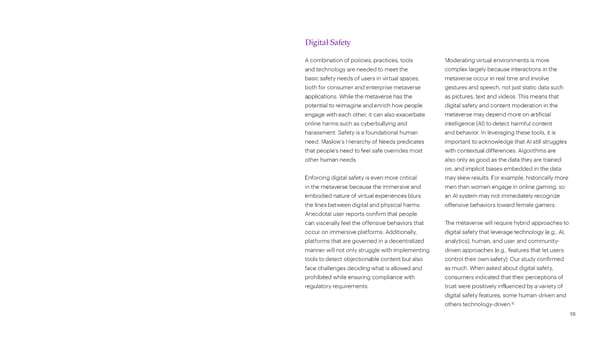
This is a modal window.
Building a Responsible Metaverse Key Takeaway Most Influential Safety Features 18-40 years old Over 40 years old Companies, governments and civil societies must partner to overcome significant challenges to digital 1 Mechanisms to combat Features that allow users to safety, and to ensure that virtual misinformation control their own safety environments do not compromise the health and well-being of users. Features that allow users to Built-in mechanisms to penalize These public-private partnerships 2 control their own safety users for bad behaviours should identify and prioritize online harms in the metaverse (such as misinformation, bullying Cross-industry standards Mechanisms to combat and extremism); build tools and 3 for trust & safety misinformation technology to combat harmful content; and invest in talent to Human moderators that Enforcing use of real names and support platform integrity and 4 proactively monitor user vetting users’ identitites community managers. interactions and experiences 5 Built-in mechanisms to penalize Clearly written and communicated users for bad behaviours community guidelines Figure 4: Safety features affecting perceptions of trust 16

Building a Responsible Metaverse Sustainability Climate concerns and systemic inequalities The metaverse could replace some carbon- Key Takeaway have elevated environmental sustainability to intensive activities, such as business travel, and one of the greatest priorities of our generation. enhance everyday chores such as shopping. As witnessed in past decades, technology A “try before you buy” virtual environment and Be intentional about when and presents both opportunities and challenges immersive storytelling can help bridge the how your organization uses the for sustainability. It is possible, then, to strike a intention-action gap in consumers while saving metaverse, and understand how balance between the energy and data demands them transportation costs and time. it advances as well as hampers of the metaverse and sustainability. your sustainability commitments. The potential is vast, and creating immersive Identify the sustainability levers For example, digital twins—virtual replicas of experiences requires significant computing your organization controls and physical processes and business activities— power, data storage and new devices. Effects determine key performance promote efficiency. Digital twin solutions include increased global carbon emissions, indicators that measure progress connect assets in a portfolio, business unit or electricity use and e-waste, and less biodiversity. and drive accountability for organization to create a system-level view that Similarly, some popular blockchain applications metaverse sustainability across can unlock 20-30% in trapped value through are maintained by decentralized networks, the enterprise. enterprise and asset improvements. Digital twins some of which utilize proof-of-work consensus let manufacturers visualize new product models mechanisms that require significant electricity Simultaneously, explore how the 13 metaverse can drive innovative with immense detail to reduce wasteful churn, and computing needs. The problem is and even help energy companies optimize that sustainability disclosures around these solutions to champion sustainability. their use of water through real-time data and technologies are not yet globally available. connected machinery. Without the underlying data, it is difficult to quantify the problem and determine which actions will yield the largest impact. 17
Building a Responsible Metaverse Organizations should ask two questions: How can I use the metaverse sustainably? How can I become net more sustainable by leveraging the metaverse? 18
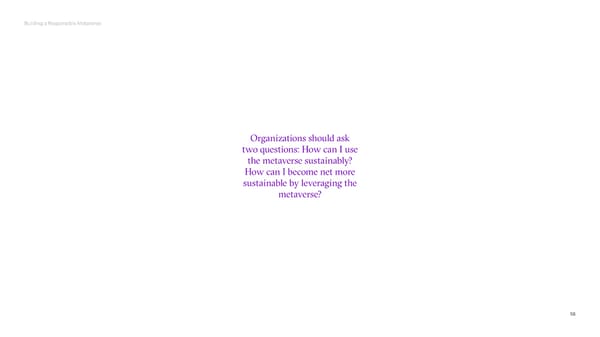
Building a Responsible Metaverse Although identity has limitless expressions, the places created in the metaverse must be bound by codes and boundaries designed to care for all. As in the past, social media and online gaming can address or perpetuate antisocial behaviors. Additionally, organizations must account for the unequal distribution of and access to infrastructure, wealth and technology, which could potentially widen the digital divide. Inclusion and Identity Virtual environments are powerful tools for engendering authentic representation. This came through in our consumer survey, where 73% of those under age 40 agreed they wanted the freedom to change their avatars depending on the circumstance, and to have their avatars 14 look like whatever and whoever they want. But if those choices can offend or mislead others, what responsibility should be attached to such freedom? The freedom to be an authentic self is often associated Although identity has limitless with a sense of well-being: to be recognized expressions, the places created in for who we really are. On the other hand, in the metaverse must be bound by the wrong circumstances, our identities can codes and boundaries designed to make us targets—for discrimination, othering, care for all. stereotyping, even assault. As in the real world, we need to feel secure, respected and accepted in these newly created spaces. 19
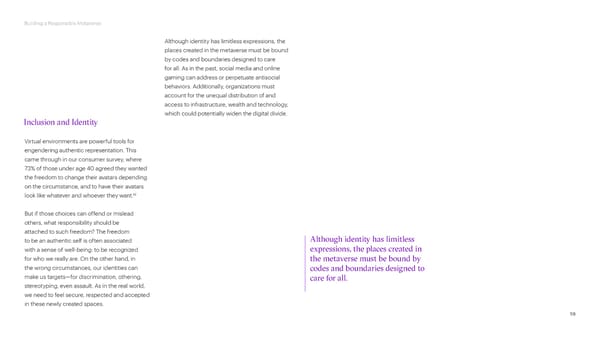
BBuiuilldinding a Rg a Reessppoonnssibiblle Me Meettaavveerrssee Key Takeaway Organizations must work together to actively shape the norms regarding digital self-expression by embedding inclusivity throughout the design process. Best practices and design principles can guide how designers, creators, developers and users contribute to inclusive and accessible metaverse experiences. Product teams must consider the full diversity of the users they aim to serve to address their specific needs—from different hair options and ethnic features to body types, neurodiversity requirements and more. 20
Building a Responsible Metaverse It is reasonable to expect companies, to approach the metaverse with equal parts excitement and trepidation by asking themselves: How do we get started? What is important, however, is not to get distracted by the novelty of the metaverse, and instead use this opportunity to position the entire enterprise for growth, without sacrificing core values. Whether using the metaverse to transform enterprise operations, reimagine the employee experience or engage with consumers in new ways, companies should take the following actions to realize enduring value: 21
Building a Responsible Metaverse Values to realize enduring success 1 2 Designate a leader to ensure your organization Establish principles and guidance for designs and deploys the metaverse responsible innovation and use of the responsibly. metaverse for your organization. In the near term, this person will need to focus Leverage a comprehensive framework that on privacy, security and safety because they are addresses the eight dimensions of responsibility paramount in the near-term—table stakes for (refer to Figure 1). These elements are earning user trust. It is also important to prioritize interconnected, so one aspect should not be embedding inclusion, diversity, sustainability and prioritized at the expense of another. Think of well-being into your metaverse use case strategy them as panels of a soccer ball: if one of the eight and design to maintain that hard-earned trust dimensions is devalued or ignored, the entire over time. framework—that provides a safe user experience and value to organizations—quickly deflates. 22
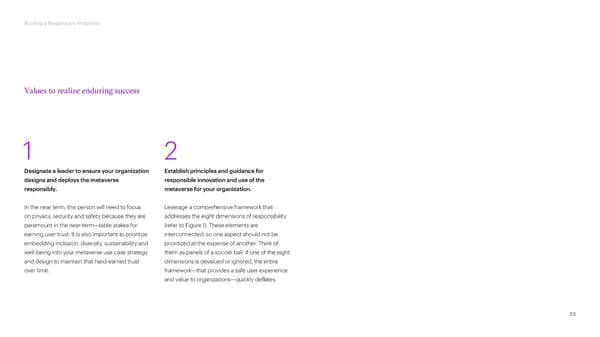
This is a modal window.
Building a Responsible Metaverse 3 Decode the challenges the metaverse creates for your organization and apply a decision framework to help you navigate the metaverse responsibly and strategically. Trust and safety—and associated issues related to content moderation and brand safety—will become even more complex, and also more important in the metaverse. Every organization that is using the metaverse should establish a trust and safety strategy. This means implementing an approach to prevent and mitigate toxicity, promote civility and deploying tools, technology and talent that are agile and scalable to ensure that the metaverse is safe for your customers and employees. To identify the right solution to these challenges, companies should consider applying the following approach: Authenticity: Ensure that you use the Adaptability: Anticipate disruptive scenarios metaverse in a manner that is consistent with and make sure innovations in the metaverse can your core mission and values and in a manner withstand change. Example: Make metaverse that safeguards brand integrity. Example: technology decisions today that preserve your Consider how your organization’s commitments ability to pivot and adapt tomorrow as the to sustainability and inclusion should influence technology and competitive landscape evolves use cases for digital assets. (e.g., degree of interoperability). Accountability: Establish strong governance Acceptability: Understand who your and accountability to build and maintain user stakeholders are, and their needs and trust. Example: Leverage processes, metrics and expectations from the metaverse experience, mechanisms to ensure your organization has to build trusted experiences that meet their adequate accountability measures in place and expectations. Example: Your design choices can respond quickly and decisively if necessary. should adhere to the highest standards for safety, privacy and well-being, particularly use cases that involve younger users. The metaverse is more than a new technology. It is a new platform for engagement, collaboration and commerce. Organizations across the metaverse ecosystem have a role to play to build a responsible metaverse, one with trusted technologies and human-centered experiences. 23
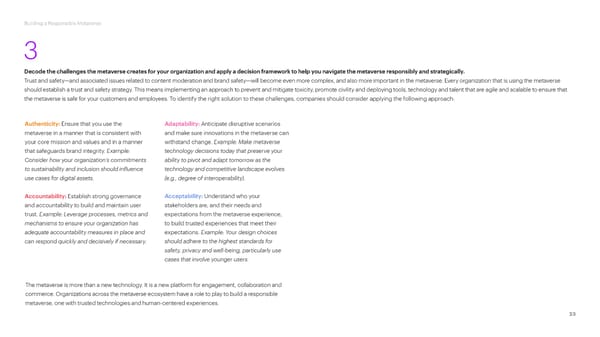
Building a Responsible Metaverse The metaverse should welcome everyone, Travelers might be able to wander a digital twin but that does not mean it will be for everyone. of Pompeii and get a sense of the culture before Previous iterations of virtual worlds were more Vesuvius covered the city in ash. As individuals, or less an escape from reality. If we build it we can even live the experience of those right, the metaverse will not be seen as a way to around us, to more deeply understand people withdraw from life, but an additional layer that from different backgrounds, communities and enriches it. circumstances, and expand our real-world sense of empathy. The metaverse is already a place for consumers to try on clothes virtually before buying them If all these possibilities and others like them are and where colleagues can convene meetings to come to fruition, companies need to partner and collaborate on projects. And it can and will and invest, now, not only in preventing the bad, be so much more. but in building incentives to create a trusted, safe, healthy and welcoming metaverse. The metaverse can be a place where surgeons hone their craft, or infectious disease specialists Of course, even with a responsible metaverse diagnose and treat patients in remote places. framework, building safe spaces will be an A university student studying history could iterative, agile development process, requiring engage in conversations with everyone from a broad range of voices and philosophies. Yet Marie Curie to Julius Caesar. A middle-school everyone can agree that we stand, collectively, student could meet with his or her math tutor at a virtual doorway unlike any other in recent across the country as if they are in the same history. We have a rare opportunity to ensure room and, after cracking quadratic equations, that a new, life-changing and enriching explore the surface of the moon. On a tour of technology does not outpace society’s best If we build it right, the metaverse the Louvre in Paris, visitors could not only look intentions, and instead helps us realize them. will not be seen as a way to at the Mona Lisa, but ask Leonardo, as he is withdraw from life, but an additional painting, in which direction she is truly looking. layer that enriches it. 24

Building a Responsible Metaverse 1 Accenture Responsible Metaverse Extended Reality 12 Accenture Responsible Metaverse Extended Reality “Axie Infinity: Live Player Count and Statistics.” The Game Krstic, Branko. “15+ Mind-Boggling Minecraft Statistics Study 2022, N= 8503 Study 2022, N= 8503 Statistics Authority : ActivePlayer.io, ActivePlayer, 26 July for the Dedicated Gamer.” WebTribunal, WebTribunal, 14 2 Accenture Responsible Metaverse Web3 Study 2022, 13 Note: Unlike blockchains with decentralized networks, 2022, https://activeplayer.io/axie-infinity/. June 2022, https://webtribunal.net/blog/minecraft-statis- N= 9005 enterprise-grade blockchain platforms do not require tics/#gref. consensus mechanisms and, as such, are energy Bloomberg Intelligence. “Metaverse May Be $800 Billion “Marketplace Analytics.” Upland, Upland, 2022, 3 Accenture Responsible Metaverse Extended Reality efficient. Additionally, since the Ethereum Merge, Market, next Tech Platform.” Bloomberg, 1 Dec. 2021, https://www.upland.me/marketplace-analytics. Study 2022, N= 8503 there are fewer users engaging with blockchains that https://www.bloomberg.com/professional/blog/metaverse- use proof-of-work consensus mechanisms. The Merge may-be-800-billion-market-next-tech-platform/. Morris, Chris. “Citi Says Metaverse Economy Could Be Worth 4 Accenture Responsible Metaverse Web3 Study 2022, refers to the original Ethereum Mainnet merging with a $13 Trillion by 2030.” Fortune, 1 Apr. 2022, https://fortune. N= 9005 separate proof-of-stake blockchain called the Beacon Clement, J. “Roblox Corporation - Statistics & Facts.” Statis- com/2022/04/01/citi-metaverse-economy-13-trillion-2030/. 5 Accenture Responsible Metaverse Web3 Study 2022, Chain, now existing as one chain. The Merge reduced ta, Statista, 18 Oct. 2022, https://www.statista.com/top- N= 9005 Ethereum’s energy consumption by ~99.95%. ics/7594/roblox-corporation/#topicHeader__wrapper. Morgan, R. M., & Hunt, S. D. (1994). The Com- mitment-Trust Theory of Relationship Marketing. 6 Research has found this to be consistent over many 14 Accenture Responsible Metaverse Extended Reality Ethereum. “The Merge.” Ethereum, 16 Sept. 2022, Journal of Marketing, 58(3), 20–38. https://doi. years, since the idea was first explored in depth by Study 2022, N= 8503 https://ethereum.org/en/upgrades/merge/. org/10.1177/002224299405800302 Robert M. Morgan and Shelby D. Hunt in their 1994 pa- per, “https://journals.sagepub.com/doi/abs/10.1177/00 Greener, Rory. “Second Life Storefront User Traffic Jumps Mozilla. “Unknown Influence | Social Media, Democracy and 2224299405800302”The Commitment-Trust Theory of 35 Percent in 2021.” XR Today, X Today, 12 Jan. 2022, https:// Transparency.” Youtube, 25 Oct. 2022, https://www.youtube. Relationship Marketing. www.xrtoday.com/virtual-reality/second-life-user-traffic- com/watch?v=bNRwTz6lH04. 7 Accenture Responsible Metaverse Extended Reality jumps-35-percent-in-2021/#:~:text=Since%20its%20incep- Study 2022, N= 8503 tion%2C%20Second%20Life,active%20users%20on%20 Nguyen, Minh-Ngoc. “Axie Infinity: Players by Country its%20platform. 2022.” Statista, Statista, 14 June 2022, https://www.statista. 8 Social platforms’ global trust and transparency issues com/statistics/1314090/axie-infinity-players-by-country/. are explored in greater detail in a 2022 video by Mo- Hernandez, Ornella. “Metaverse Platforms Set the Record zilla, “https://www.youtube.com/watch?v=bNRwTz6l- Straight about Daily Active Users.” Blockworks, Blockworks, Tassi, Paul. “Meta’s ‘Horizon Worlds’ Has Somehow Lost H04”Unknown Influence: Social media, democracy and 14 Oct. 2022, https://blockworks.co/news/metaverse-plat- 100,000 Players in Eight Months.” Forbes, Forbes Maga- transparency. forms-set-the-record-straight-about-daily-active-users. zine, 18 Oct. 2022, https://www.forbes.com/sites/paultas- 9 Accenture Responsible Metaverse Extended Reality si/2022/10/17/metas-horizon-worlds-has-somehow-lost- Study 2022, N= 8503 Iqbal, Mansoor. “Fortnite Usage and Revenue Statistics 100000-players-in-eight-months/?sh=20392d9d2a1b. (2022).” Business of Apps, Business of Apps, 6 Sept. 2022, 10 Accenture Responsible Metaverse Web3 Study 2022, https://www.businessofapps.com/data/fortnite-statistics/. “Upland.” DappRadar, DappRadar, 2022, https://dappradar. N= 9005 com/eos/games/upland#dappradar-full-description. 11 Accenture Responsible Metaverse Extended Reality Study 2022, N= 8503 25

Building a Responsible Metaverse Authors About the Research About Accenture Accenture Research Denise Zheng In August and September 2022, Accenture Accenture is a global professional services Accenture Research shapes trends and creates Managing Director, Metaverse conducted a two-part survey to understand company with leading capabilities in digital, data-driven insights about the most pressing Continuum Business Group & consumer perceptions of the metaverse. The cloud and security. Combining unmatched issues global organizations face. Combining the Responsible Metaverse Lead study was global, spanning 19 countries, with experience and specialized skills across power of innovative research techniques with 500 respondents per country. more than 40 industries, we offer Strategy a deep understanding of our clients’ industries, Paul Daugherty and Consulting, Technology and Operations our team of 300 researchers and analysts Accenture Group Chief The extended reality survey of 8,503 services and Accenture Song — all powered spans 20 countries and publishes hundreds of Executive – Technology consumers focused on perceptions of by the world’s largest network of Advanced reports, articles and points of view every year. and Chief Technology Officer immersive experiences in the metaverse. The Technology and Intelligent Operations centers. Our thought-provoking research – supported by web3 survey of 9,005 consumers focused on Our 721,000 people deliver on the promise of proprietary data and partnerships with leading their perceptions of cryptocurrencies, NFTs, technology and human ingenuity every day, organizations, such as MIT and Harvard – guides and DAOs. serving clients in more than 120 countries. We our innovations and allows us to transform embrace the power of change to create value theories and fresh ideas into real-world solutions and shared success for our clients, people, for our clients. For more information, visit www. Region Countries shareholders, partners and communities. Visit accenture.com/research. us at www.accenture.com. . USA English-Speaking Canada Countries UK South Africa Australia Spain Europe France Germany Italy Sweden Acknowledgements China Japan Singapore Copyright © 2023 Accenture. APAC Thailand We thank everyone in the Metaverse Philippines All rights reserved. Continuum Business Group who India South Korea assisted with the research, insights Brazil Accenture, its logo, and New Applied Now are and the implementation of the report. LATAM Mexico trademarks of Accenture. 26


